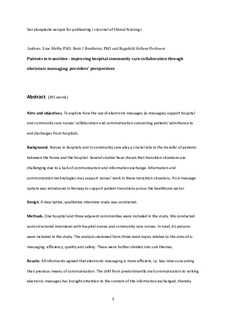| dc.contributor.author | Melby, Line | |
| dc.contributor.author | Brattheim, Berit | |
| dc.contributor.author | Hellesø, Ragnhild | |
| dc.date.accessioned | 2017-11-06T12:49:01Z | |
| dc.date.available | 2017-11-06T12:49:01Z | |
| dc.date.created | 2016-01-17T16:23:36Z | |
| dc.date.issued | 2015 | |
| dc.identifier.citation | Journal of Clinical Nursing. 2015, 24 (23-24), 3389-3399. | nb_NO |
| dc.identifier.issn | 0962-1067 | |
| dc.identifier.uri | http://hdl.handle.net/11250/2464261 | |
| dc.description.abstract | Aims and objectives: To explore how the use of electronic messages support hospital and community care nurses’ collaboration and communication concerning patients’ admittance to and discharges from hospitals. Background: Nurses in hospitals and in community care play a crucial role in the transfer of patients between the home and the hospital. Several studies have shown that transition situations are challenging due to a lack of communication and information exchange. Information and communication technologies may support nurses’ work in these transition situations. An electronic message system was introduced in Norway to support patient transitions across the health care sector. Design: A descriptive, qualitative interview study was conducted. Methods: One hospital and three adjacent communities were included in the study. We conducted semi-structured interviews with hospital nurses and community care nurses. In total, 41 persons were included in the study. The analysis stemmed from three main topics related to the aims of e-messaging: efficiency, quality and safety. These were further divided into sub-themes. Results: All informants agreed that electronic messaging is more efficient, i.e. less time-consuming than previous means of communication. The shift from predominantly oral communication to writing electronic messages has brought attention to the content of the information exchanged, thereby leading to more conscious communication. Electronic messaging enables improved information security, thereby enhancing patient safety, but this depends on nurses using the system as intended. Conclusion: Nurses consider electronic messaging to be a useful tool for communication and collaboration in patient transitions. Relevance to clinical practice: Patient transitions are demanding situations both for patients and for the nurses who facilitate the transitions. The introduction of information and communication technologies can support nurses’ work in the transition situations, and this is likely to benefit the patients. | nb_NO |
| dc.language.iso | eng | nb_NO |
| dc.publisher | Wiley | nb_NO |
| dc.title | Patients in transition – improving hospital–home care collaboration through electronic messaging: providers’ perspectives | nb_NO |
| dc.type | Journal article | nb_NO |
| dc.type | Peer reviewed | nb_NO |
| dc.description.version | acceptedVersion | nb_NO |
| dc.source.pagenumber | 3389-3399 | nb_NO |
| dc.source.volume | 24 | nb_NO |
| dc.source.journal | Journal of Clinical Nursing | nb_NO |
| dc.source.issue | 23-24 | nb_NO |
| dc.identifier.doi | 10.1111/jocn.12991 | |
| dc.identifier.cristin | 1315094 | |
| dc.relation.project | Norges forskningsråd: 229623 | nb_NO |
| dc.description.localcode | This is the peer reviewed version of the following article: [Patients in transition – improving hospital–home care collaboration through electronic messaging: providers’ perspectives], which has been published in final form at [http://onlinelibrary.wiley.com/doi/10.1111/jocn.12991/abstract]. This article may be used for non-commercial purposes in accordance with Wiley Terms and Conditions for Self-Archiving. | nb_NO |
| cristin.unitcode | 194,65,25,0 | |
| cristin.unitname | Institutt for sirkulasjon og bildediagnostikk | |
| cristin.ispublished | true | |
| cristin.fulltext | postprint | |
| cristin.qualitycode | 2 | |
